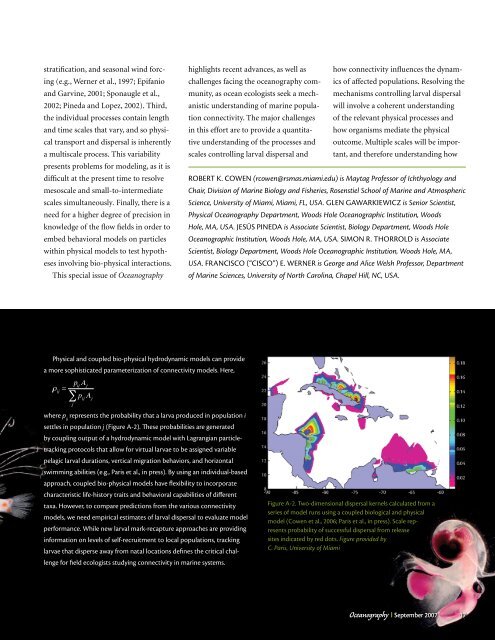Population Connectivity in Marine Systems
Population Connectivity in Marine Systems
Population Connectivity in Marine Systems
Create successful ePaper yourself
Turn your PDF publications into a flip-book with our unique Google optimized e-Paper software.
stratification, and seasonal w<strong>in</strong>d forc<strong>in</strong>g<br />
(e.g., Werner et al., 1997; Epifanio<br />
and Garv<strong>in</strong>e, 2001; Sponaugle et al.,<br />
2002; P<strong>in</strong>eda and Lopez, 2002). Third,<br />
the <strong>in</strong>dividual processes conta<strong>in</strong> length<br />
and time scales that vary, and so physical<br />
transport and dispersal is <strong>in</strong>herently<br />
a multiscale process. This variability<br />
presents problems for model<strong>in</strong>g, as it is<br />
difficult at the present time to resolve<br />
mesoscale and small-to-<strong>in</strong>termediate<br />
scales simultaneously. F<strong>in</strong>ally, there is a<br />
need for a higher degree of precision <strong>in</strong><br />
knowledge of the flow fields <strong>in</strong> order to<br />
embed behavioral models on particles<br />
with<strong>in</strong> physical models to test hypotheses<br />
<strong>in</strong>volv<strong>in</strong>g bio-physical <strong>in</strong>teractions.<br />
This special issue of Oceanography<br />
Physical and coupled bio-physical hydrodynamic models can provide<br />
a more sophisticated parameterization of connectivity models. here,<br />
where p ij represents the probability that a larva produced <strong>in</strong> population i<br />
settles <strong>in</strong> population j (Figure A-2). These probabilities are generated<br />
by coupl<strong>in</strong>g output of a hydrodynamic model with lagrangian particle-<br />
track<strong>in</strong>g protocols that allow for virtual larvae to be assigned variable<br />
pelagic larval durations, vertical migration behaviors, and horizontal<br />
swimm<strong>in</strong>g abilities (e.g., Paris et al., <strong>in</strong> press). By us<strong>in</strong>g an <strong>in</strong>dividual-based<br />
approach, coupled bio-physical models have flexibility to <strong>in</strong>corporate<br />
characteristic life-history traits and behavioral capabilities of different<br />
taxa. however, to compare predictions from the various connectivity<br />
models, we need empirical estimates of larval dispersal to evaluate model<br />
performance. while new larval mark-recapture approaches are provid<strong>in</strong>g<br />
<strong>in</strong>formation on levels of self-recruitment to local populations, track<strong>in</strong>g<br />
larvae that disperse away from natal locations def<strong>in</strong>es the critical challenge<br />
for field ecologists study<strong>in</strong>g connectivity <strong>in</strong> mar<strong>in</strong>e systems.<br />
highlights recent advances, as well as<br />
challenges fac<strong>in</strong>g the oceanography community,<br />
as ocean ecologists seek a mechanistic<br />
understand<strong>in</strong>g of mar<strong>in</strong>e population<br />
connectivity. The major challenges<br />
<strong>in</strong> this effort are to provide a quantitative<br />
understand<strong>in</strong>g of the processes and<br />
scales controll<strong>in</strong>g larval dispersal and<br />
how connectivity <strong>in</strong>fluences the dynamics<br />
of affected populations. Resolv<strong>in</strong>g the<br />
mechanisms controll<strong>in</strong>g larval dispersal<br />
will <strong>in</strong>volve a coherent understand<strong>in</strong>g<br />
of the relevant physical processes and<br />
how organisms mediate the physical<br />
outcome. Multiple scales will be important,<br />
and therefore understand<strong>in</strong>g how<br />
rOBert K. COweN (rcowen@rsmas.miami.edu) is Maytag Professor of Ichthyology and<br />
Chair, Division of Mar<strong>in</strong>e Biology and Fisheries, Rosenstiel School of Mar<strong>in</strong>e and Atmospheric<br />
Science, University of Miami, Miami, FL, USA. GleN GAwArKiewiCz is Senior Scientist,<br />
Physical Oceanography Department, Woods Hole Oceanographic Institution, Woods<br />
Hole, MA, USA. JeSúS PiNedA is Associate Scientist, Biology Department, Woods Hole<br />
Oceanographic Institution, Woods Hole, MA, USA. SiMON r. thOrrOld is Associate<br />
Scientist, Biology Department, Woods Hole Oceanographic Institution, Woods Hole, MA,<br />
USA. FrANCiSCO (“CiSCO”) e. werNer is George and Alice Welsh Professor, Department<br />
of Mar<strong>in</strong>e Sciences, University of North Carol<strong>in</strong>a, Chapel Hill, NC, USA.<br />
Figure A-2. two-dimensional dispersal kernels calculated from a<br />
series of model runs us<strong>in</strong>g a coupled biological and physical<br />
model (Cowen et al., 2006; Paris et al., <strong>in</strong> press). Scale represents<br />
probability of successful dispersal from release<br />
sites <strong>in</strong>dicated by red dots. Figure provided by<br />
C. Paris, University of Miami<br />
Oceanography September 2007 17
















